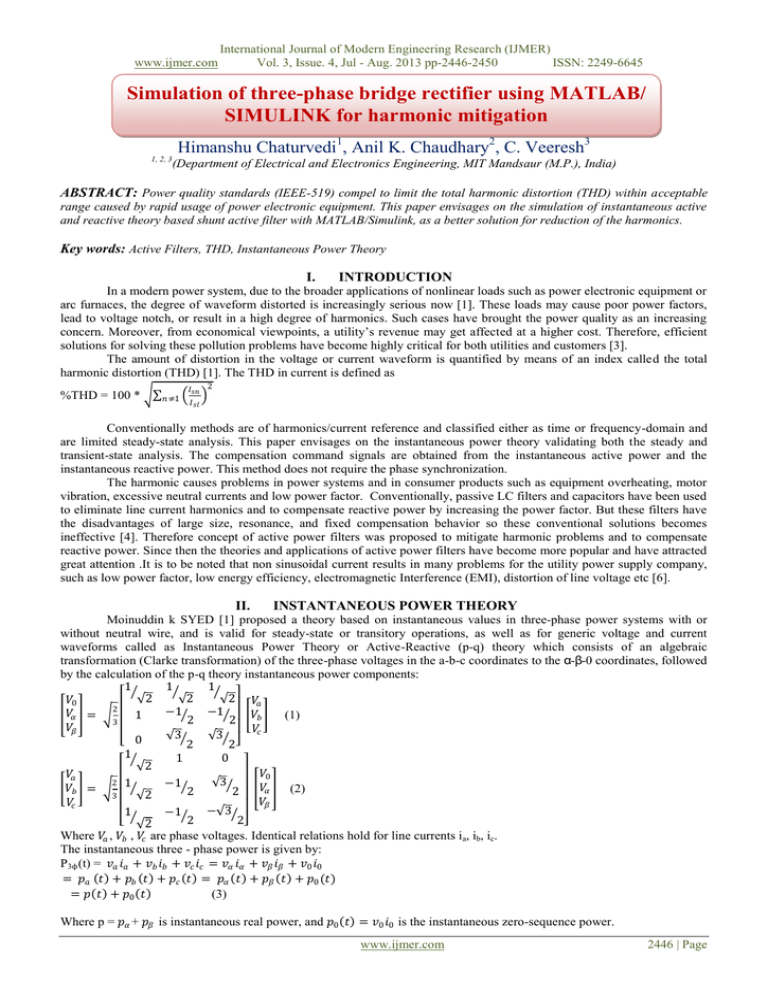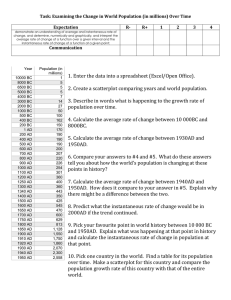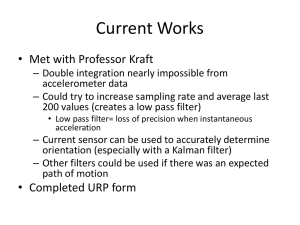Simulation of three-phase bridge rectifier using MATLAB/SIMULINK
advertisement

www.ijmer.com International Journal of Modern Engineering Research (IJMER) Vol. 3, Issue. 4, Jul - Aug. 2013 pp-2446-2450 ISSN: 2249-6645 Simulation of three-phase bridge rectifier using MATLAB/ SIMULINK for harmonic mitigation Himanshu Chaturvedi1, Anil K. Chaudhary2, C. Veeresh3 1, 2, 3 (Department of Electrical and Electronics Engineering, MIT Mandsaur (M.P.), India) ABSTRACT: Power quality standards (IEEE-519) compel to limit the total harmonic distortion (THD) within acceptable range caused by rapid usage of power electronic equipment. This paper envisages on the simulation of instantaneous active and reactive theory based shunt active filter with MATLAB/Simulink, as a better solution for reduction of the harmonics. Key words: Active Filters, THD, Instantaneous Power Theory I. INTRODUCTION In a modern power system, due to the broader applications of nonlinear loads such as power electronic equipment or arc furnaces, the degree of waveform distorted is increasingly serious now [1]. These loads may cause poor power factors, lead to voltage notch, or result in a high degree of harmonics. Such cases have brought the power quality as an increasing concern. Moreover, from economical viewpoints, a utility’s revenue may get affected at a higher cost. Therefore, efficient solutions for solving these pollution problems have become highly critical for both utilities and customers [3]. The amount of distortion in the voltage or current waveform is quantified by means of an index called the total harmonic distortion (THD) [1]. The THD in current is defined as %THD = 100 * 𝑛≠1 𝐼𝑠𝑛 2 𝐼𝑠𝑙 Conventionally methods are of harmonics/current reference and classified either as time or frequency-domain and are limited steady-state analysis. This paper envisages on the instantaneous power theory validating both the steady and transient-state analysis. The compensation command signals are obtained from the instantaneous active power and the instantaneous reactive power. This method does not require the phase synchronization. The harmonic causes problems in power systems and in consumer products such as equipment overheating, motor vibration, excessive neutral currents and low power factor. Conventionally, passive LC filters and capacitors have been used to eliminate line current harmonics and to compensate reactive power by increasing the power factor. But these filters have the disadvantages of large size, resonance, and fixed compensation behavior so these conventional solutions becomes ineffective [4]. Therefore concept of active power filters was proposed to mitigate harmonic problems and to compensate reactive power. Since then the theories and applications of active power filters have become more popular and have attracted great attention .It is to be noted that non sinusoidal current results in many problems for the utility power supply company, such as low power factor, low energy efficiency, electromagnetic Interference (EMI), distortion of line voltage etc [6]. II. INSTANTANEOUS POWER THEORY Moinuddin k SYED [1] proposed a theory based on instantaneous values in three-phase power systems with or without neutral wire, and is valid for steady-state or transitory operations, as well as for generic voltage and current waveforms called as Instantaneous Power Theory or Active-Reactive (p-q) theory which consists of an algebraic transformation (Clarke transformation) of the three-phase voltages in the a-b-c coordinates to the α-β-0 coordinates, followed by the calculation of the p-q theory instantaneous power components: 1 1 1 2 2 2 𝑉𝑎 𝑉0 −1 −1 𝑉𝛼 = 2 1 (1) 2 2 𝑉𝑏 3 𝑉𝛽 𝑉𝑐 3 3 0 2 2 1 1 0 2 𝑉0 𝑉𝑎 2 1 3 −1 𝑉𝛼 𝑉𝑏 = (2) 2 2 3 2 𝑉𝛽 𝑉𝑐 − 3 1 −1 2 2 2 Where 𝑉𝑎 , 𝑉𝑏 , 𝑉𝑐 are phase voltages. Identical relations hold for line currents ia, ib, ic. The instantaneous three - phase power is given by: P3ϕ (t) = 𝑣𝑎 𝑖𝑎 + 𝑣𝑏 𝑖𝑏 + 𝑣𝑐 𝑖𝑐 = 𝑣𝛼 𝑖𝛼 + 𝑣𝛽 𝑖𝛽 + 𝑣0 𝑖0 = 𝑝𝑎 𝑡 + 𝑝𝑏 𝑡 + 𝑝𝑐 𝑡 = 𝑝𝛼 𝑡 + 𝑝𝛽 𝑡 + 𝑝0 (𝑡) = 𝑝 𝑡 + 𝑝0 𝑡 (3) Where p = 𝑝𝛼 + 𝑝𝛽 is instantaneous real power, and 𝑝0 𝑡 = 𝑣0 𝑖0 is the instantaneous zero-sequence power. www.ijmer.com 2446 | Page International Journal of Modern Engineering Research (IJMER) www.ijmer.com Vol. 3, Issue. 4, Jul - Aug. 2013 pp-2446-2450 ISSN: 2249-6645 One advantage of using the transformation of α-β-0 is to separate the zero-sequence component of the system. The reactive power measurement can be give by 𝑞 𝑡 ≈ 𝑣𝛼 𝑖𝛽 − 𝑣𝛽 𝑖𝛼 (4) Rewritten in terms of a-b-c components as 𝑞 = − 𝑣𝑎 − 𝑣𝑏 𝑖𝑐 + 𝑣𝑏 − 𝑣𝑐 𝑖𝑎 + 𝑣𝑐 − 𝑣𝑎 𝑖𝑏 (5) 3 The power p and q can be rewritten as 𝑣𝛼 𝑣𝛽 𝑖𝛼 𝑝 (6) 𝑞 = −𝑣𝛽 𝑣𝛼 𝑖𝛽 From this matrix equation, for ∆= 𝑣𝛼 2 + 𝑣𝛽2 −𝑣𝛽 𝑝 𝑖𝛼 1 𝑣𝛼 (7) 𝑣𝛼 𝑞 𝑖𝛽 = ∆ 𝑣𝛽 Separating the Active and Reactive parts −𝑣𝛽 𝑝 𝑣𝛼 −𝑣𝛽 0 𝑖𝛼 1 𝑣𝛼 𝑣𝛼 0 + 𝑣𝛽 𝑣𝛼 𝑖𝛽 = ∆ 𝑣𝛽 𝑞 𝑖𝛼𝑝 𝑖𝛼𝑞 ≅ + (8) 𝑖𝛽𝑝 𝑖𝛽𝑞 Where, the current components are 𝑖𝛼𝑝 = 𝑣𝛼 𝑝/∆ , 𝑖𝛼𝑞 = −𝑣𝛽 𝑞/∆ (9) 𝑖𝛽𝑝 = 𝑣𝛽 𝑝/∆ , 𝑖𝛽𝑞 = −𝑣𝛼 𝑞/∆ (10) Power in phases α and β can be separated as 𝑝𝛼 𝑣𝛼 𝑖𝛼𝑝 𝑣𝛼 𝑖𝛼𝑞 𝑣𝛼 𝑖𝛼 𝑝𝛽 = 𝑣𝛽 𝑖𝛽 = 𝑣𝛽 𝑖𝛽𝑝 + 𝑣𝛽 𝑖𝛽𝑞 𝑝𝛼𝑝 𝑝𝛼𝑞 ≅ 𝑝 + 𝑝 (11) 𝛽𝑝 𝛽𝑞 Where, the power components are 𝑝𝛼𝑝 = 𝑣𝛼 𝑖𝛼𝑝 = 𝑣𝛼2 𝑝/∆ (12) 𝑝𝛼𝑞 = 𝑣𝛼 𝑖𝛼𝑞 = −𝑣𝛼 𝑣𝛽 𝑞/∆ (13) 𝑝𝛽𝑝 = 𝑣𝛽 𝑖𝛽𝑝 = 𝑣𝛽2 𝑝/∆ (14) 𝑝𝛽𝑞 = 𝑣𝛽 𝑖𝛽𝑞 = 𝑣𝛼 𝑣𝛽 𝑞/∆ (15) Therefore the three phase active power can be rewritten 𝑝3∅ = 𝑝𝛼 + 𝑝𝛽 + 𝑝0 =𝑝𝛼𝑝 + 𝑝𝛼𝑞 + 𝑝𝛽𝑝 + 𝑝𝛽𝑞 + 𝑝0 = 𝑝𝛼𝑝 + 𝑝𝛽𝑝 + 𝑝0 (16) Thus from equations (13) and (15) 𝑝𝛼𝑞 + 𝑝𝛽𝑞 = 0 (17) Thus 𝑝𝛼𝑝 − 𝛼 axis instantaneous active power. 𝑝𝛽𝑝 − 𝛽 axis instantaneous active power. 𝑝𝛼𝑞 − 𝛼 axis instantaneous reactive power. 𝑝𝛽𝑞 − 𝛽 axis instantaneous reactive power. It is observed that the reactive power corresponds to the parts of instantaneous power, which is dependent on the instantaneous imaginary power q, in each independent phase and vanishes when added (𝑝𝛼𝑞 + 𝑝𝛽𝑞 = 0), in a two-phase (𝛼 − 𝛽) system. Instantaneous real power p, gives the net energy per second being transported from source to load and vice-versa at any time, which is dependent only on the voltage and currents in phases α and β and has no zero-sequence present. Non-linear Load The three phase sinusoidal voltages supplying a non-linear load are represented as 𝑣𝑎 = 2𝑣𝑠𝑖𝑛𝜔𝑡 𝑣𝑏 = 2𝑣𝑠𝑖𝑛(𝜔𝑡 + 120°) 𝑣𝑐 = 2𝑣𝑠𝑖𝑛(𝜔𝑡 − 120°) (18) And the currents being 𝑖𝑎 = ∞𝑛=1 2 𝐼𝑛 sin(𝑛𝜔𝑡 − ∅𝑛 ) 𝑖𝑏 = ∞𝑛=1 2 𝐼𝑛 sin[𝑛(𝜔𝑡 + 120°) − ∅𝑛 ] 𝑖𝑐 = ∞𝑛=1 2 𝐼𝑛 sin[𝑛(𝜔𝑡 − 120°) − ∅𝑛 ] (19) Then, www.ijmer.com 2447 | Page International Journal of Modern Engineering Research (IJMER) www.ijmer.com Vol. 3, Issue. 4, Jul - Aug. 2013 pp-2446-2450 ISSN: 2249-6645 𝐼𝑛 sin 𝑛𝜔𝑡 − ∅𝑛 [1 − cos 𝑛120° ] (20) 2 ∞ 𝑛=1 3 ∞ 𝑛=1 2𝐼𝑛 𝑖𝛼 = 𝑖𝛽 = 𝑖0 = ∞ 𝑛 =1 1 3 cos 𝑛𝜔𝑡 − ∅𝑛 sin 𝑛120° (21) (𝑖𝑎 + 𝑖𝑏 + 𝑖𝑐 ) 6 𝐼3𝑛 sin (3𝑛𝜔𝑡 − ∅3𝑛 ) (22) The power components p, q, p0 and 𝑝3∅ are 𝑃 = 𝑣𝛼 𝑖𝛼 + 𝑣𝛽 𝑖𝛽 = 𝑝𝛼𝑝 + 𝑝𝛽𝑝 = 3VI1cosϕ 1 - 3VI2cos(3𝜔t-ϕ 2) + 3VI4cos(3𝜔t+ϕ 4) – 3VI5cos(6𝜔t-ϕ 5) + 3VI7cos(6𝜔t+ϕ 7) - …. (23) 𝑞 = 𝑣𝛼 𝑖𝛽 − 𝑣𝛽 𝑖𝛼 = 3VI1sinϕ 1 - 3VI2sin(3𝜔t-ϕ 2) + 3VI4sin(3𝜔t+ϕ 4) – 3VI5sin(6𝜔t-ϕ 5) + 3VI7sin(6𝜔t+ϕ 7) - …. 𝑃0 = 𝑣0 𝑖0 = 0 and 𝑃3∅ = p (25) Thus, these expressions are 𝑃 = 𝑃 + 𝑃 and 𝑞 = 𝑞 + 𝑞 (24) (26) Each of these expressions represents the mean-value and alternating components with mean-value equal to zero. From (23) and (24) it can be concluded that 𝑃 = 𝑃3∅ and 𝑞 = 𝑄3∅ (27) Thus the harmonic power is given by 𝐻 = 𝑃2 + 𝑄 2 (28) Where 𝑃 and 𝑄 are the RMS values of 𝑝 and 𝑞, respectively. III. COMPENSATION STRATEGY The reactive and harmonic compensation is carried by injecting appropriate currents into the circuit through a compensator i.e., shunt active filter as shown in Fig.1. Fig.1. Strategy of Instantaneous Power Theory In order to compensate 𝑃𝛼𝑞 and 𝑃𝛽𝑞 , currents 𝑖𝛼𝑐 and 𝑖𝛽𝑐 are injected equivalent to reactive currents as 𝑖𝛼𝑐 = 𝑖𝛼𝑞 , and (29) 𝑖𝛽𝑐 = 𝑖𝛽𝑞 (30) Where, 𝑖𝛼𝑞 and 𝑖𝛽𝑞 are given by (9) and (10). The current 𝑖𝛼𝑐 is in shunt with the voltage source 𝑣𝛼 , thus supplies the power 𝑃𝛼𝑞 = 𝑣𝛼 𝑖𝛼𝑞 . Similarly, the current source 𝑖𝛽𝑐 supplies 𝑃𝛽𝑞 = 𝑣𝛽 𝑖𝛽𝑞 . Thus, the voltage source 𝑣𝛼 and 𝑣𝛽 need to supply only 𝑃𝛼𝑝 and 𝑃𝛽𝑝 . From (17), the power necessary to compensate for 𝑖𝛼𝑞 is equal to the negative of the power necessary to compensate for 𝑖𝛽𝑞 . The current source 𝑖𝛼𝑐 and 𝑖𝛽𝑐 represent active power filters that are generated from the VSI inverter controlled to generate 𝑖𝛼𝑞 and 𝑖𝛽𝑞 . As such, no DC source is necessary and also no large energy storage element is necessary to compensate the reactive power. Instantaneously, the reactive power required by one phase can be supplied by the other one. This means that, the size of the capacitor does not depend on the amount of reactive power to be compensated. In fact, in actual systems only a small capacitor is used because the switching of the inverters. As stated in (26), p can be decomposed in two parts as 𝑝 and 𝑝. As 𝑝 is the actual working power, only 𝑝 has been compensated. Thus (12) and (14) are modified to: 𝑃𝛼𝑝 = 𝑣𝛼 𝑖𝛼𝑝 = 𝑣𝛼2 𝑝/∆ (31) 𝑃𝛽𝑝 = 𝑣𝛽 𝑖𝛽𝑝 = 𝑣𝛽2 𝑝/∆ (32) The above power terms have mean-value equal to zero but their summation is not zero at every instant, that is, 𝑃𝛼𝑝 + 𝑃𝛽𝑝 ≠ 0. The capacitor receives energy when 𝑝 is negative and supplies when 𝑝 is positive. www.ijmer.com 2448 | Page www.ijmer.com International Journal of Modern Engineering Research (IJMER) Vol. 3, Issue. 4, Jul - Aug. 2013 pp-2446-2450 ISSN: 2249-6645 IV. SIMULATION RESULTS The simulation of the proposed instantaneous power theory is carried on MATLAB/Simulink as represented in the Fig.2. Fig.2. Proposed power control strategy The source supply is designed with amplitude of 360 volt and frequency of 315 rad/sec with a phase difference of 2.0944 rad between phases. The load is simulated to include harmonic distortion by injecting the diode current generated from a three phase uncontrolled diode rectifier of 36KW and a three phase fully controlled thyristor rectifier of 12KW with 60˚ firing delay angle. A VSI inverter is instantaneous and infinitely fast to track current reference and is implemented as a current amplifier with unity gain block with unity value. Fig.3. Circuit diagram of PWM Control Technique of Shunt Active Power Filter Fig.4. FFT of input AC Voltage without Filter Fig.5. FFT of input AC Current without Filter www.ijmer.com 2449 | Page www.ijmer.com International Journal of Modern Engineering Research (IJMER) Vol. 3, Issue. 4, Jul - Aug. 2013 pp-2446-2450 ISSN: 2249-6645 Fig.6. FFT of input AC Voltage with Filter Fig.7. FFT of input AC Current with Filter V. CONCLUSIONS Instantaneous power theory gives a piecemeal approach in analysis and control of the active and reactive components of the harmonic load and introduces the active power filter for appropriate corrective measure for the total harmonic distortion for improvement of the power quality as per the scheduled standards. Energy efficient power supplies incorporating active power supplies shall govern the future in the electrical power quality standardizations. REFERENCES [1] [2] [3] [4] [5] [6] [7] [8] [9] [10] [11] [12] [12] [13] [14] [15] [16] Moinuddin k SYED, “Instantaneous Power Theory Based Active Power Filter: A Matlab/ Simulink Approach” Journal of Theoretical and Applied Information Technology. Bhim Singh, “A Review of Active Filters for Power Quality Improvement” Vol.46, No.5, 1999. M. Chakravarthy,”Control of shunt active power filters in power system using MATLAB/SIMULINK” Vol. 1, pp 226, 2012 R. M. Potdar,” Comparison of topologies of shunt active power filter implemented on three phase four wire system”, Vol-1, Issue5, 2011 Suresh Mikkili, “Simulation and RTDS Hardware implementation of SHAF for mitigation of current harmonics with p-q and Id-Iq control strategies using PI controller”, Vol.1, No.3, 2011 Sachine Hirve, ”PLL-Less Active Power Filter based on one-cycle control for compensating unbalanced loads in three-phase four wire system” Vol.22, No.4, 2007 Javid Akhtar, “Modeling and Simulation of STATCOM for a power system network using MATLAB/SIMULINK”, Vol2, Issue8, pp 12-17 Sindhu.S, “Implementation of Three phase Shunt Hybrid Filter using ICOSǾ Algorithm, Vol.5, No.1, Aug2011, pp7 Ibrahim A., “Shunt Active Power Filter Based on Diode Clamped Inverter and Hysteresis band current controller”, pp84 Vaibhav Purwar, “Simulation of shunt active Power Line conditioner (APLC) for three phases AC/DC converter”, IJEECE, Vol.1 (9), 2011, 504-513 George Adam, “A MATLAB-SIMULINK APPROACH TO SHUNT ACTIVE POWER FILTERS I. Zamora, “Simulation by MATLAB/Simulink of active filters for reducing THD created by industrial systems, Mr. D.R. Dobariya, Matlab Simulation Of Hybrid Active Power Filter Using Instantaneous Reactive Power Theory Consalva J. Msigwa, “Control Algorithm for Shunt Active Power Filter using synchronous reference frame theory,WASET,2009 N. Senthilnathan, “A novel control strategy for Line harmonics reduction using three phase shunt active filter with balanced and unbalanced supply, EJSR, Vol.67,Nov.3,pp456-466 Y. Satish kumar, Instantaneous Power theory active power filter, IJASTR, Vol.4, Issue 2, 2012, pp342. J. Chelladurai, “Investigation of various PWM techniques for shunt active filter, WASET, 2008, PP192. www.ijmer.com 2450 | Page



